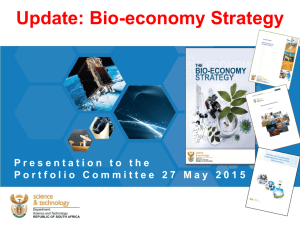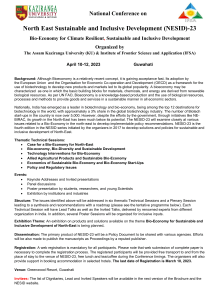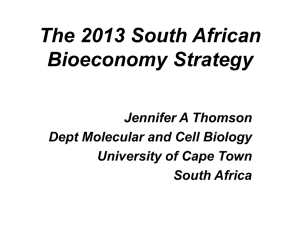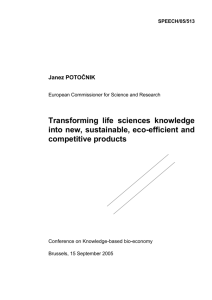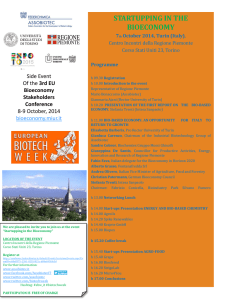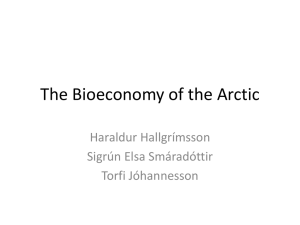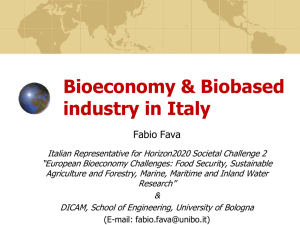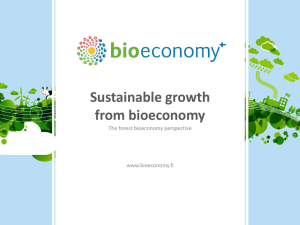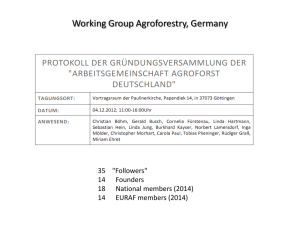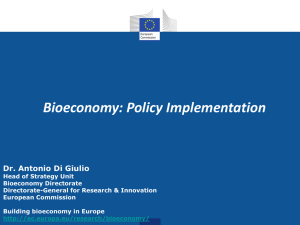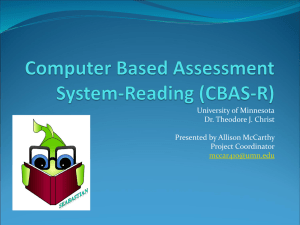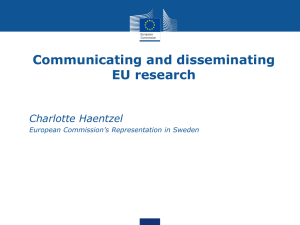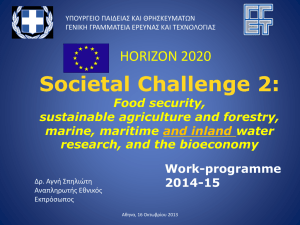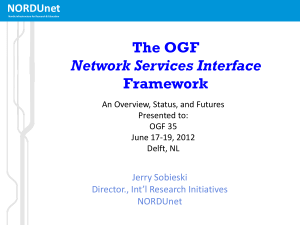Bio-economy Presentation - Animal Health Cluster 11 March 2014
advertisement
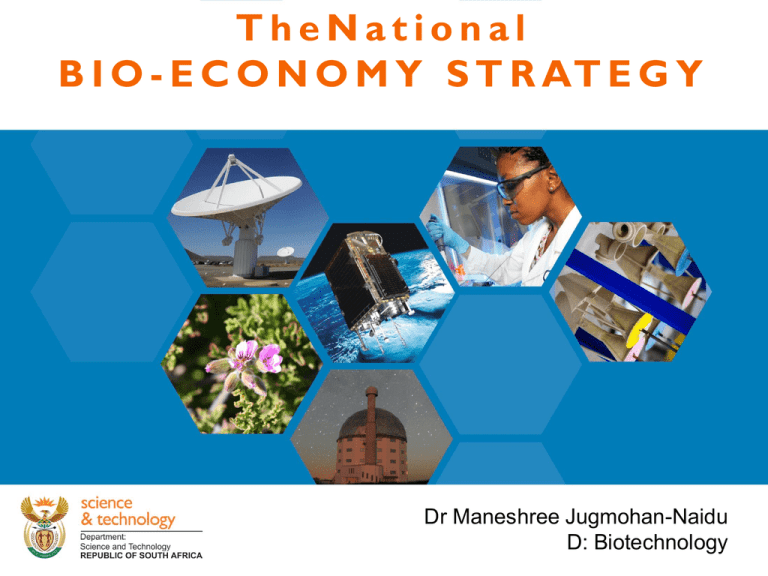
TheNational B I O - E C O N O M Y S T R AT E G Y Dr Maneshree Jugmohan-Naidu D: Biotechnology Content 1) Definition and Aims of the strategy 2) Timeline 3) Context 4) challenges/opportunities 5) Bio-economy Strategic Objectives 6) Defining progress 2 Bioeconomy Strategy 2013 "Bioeconomy" refers to activities that make use of bio-innovations, based on biological sources, materials and processes to generate sustainable economic, social and environmental development. Aims of the Bio-economy Strategy: • • • • Provides an economic engine for the new economy which will in turn provide a basis for future growth. Science-based "biosolutions" can be used to, for instance – – manufacture high-value protein products such as biopharmaceuticals and vaccines; – produce biofuels; – improve and adapt crops; – remedy industrial and municipal waste; – reduce production costs; – reduce environmental impacts; – improve improve the global competitiveness in the health, agriculture and industrial sector the quality of products; – improve the performance of a range of economic sectors. A key objective is incorporating market pull into innovation activities Allows SA to respond more directly to global challenges such as the disease burden, food security, competitive industry, climate change and energy requirements as well as to maximise local beneficiation, improved quality of life and economic growth. Linked to other policies Timeline Nat Biotech Strategy 2001 2009 Outputs: Instruments: BRICs; NBN; PUB 2003 • 14 platforms established • 73 projects funded • Investment into 31 companies • 221 products & 142 services • 940 jobs • 439 bursaries/indirect study support • R247 mill leveraged (on R1 bill) Bioeconomy 5% of GDP 2050 Incorporation of ‘learnings’ Merge into TIA 2009 Bio-economy Strategy development 2009-2013 Functioning NSI 2020 6 Value Chain Performers Funding Agencies Outputs Biotech Landscape Basic Applied Tech Develop Commercial Where to Next: Strategy to strengthen the Bioeconomy……. Universities Industry Science Councils Service Platforms SARChI CoE Centres of Competence/Platforms NIPMO NRF Publications/new knowledge/HCD TIA/DST IDC Patents/new knowledge products SWOT Analysis – SA NSI Strengths Government commitment to The Bio-economy through its policies/strategies and funding ‘Mega’ biodiversity Strong academic environment Excellent infrastructure Extensive Indigenous Knowledge Stable political environment and growing economy Emerging small companies Weaknesses Fragmented NSI - Researchers do not work together to conceptualise bigger projects which take into the value chain pipeline Innovation culture Public Awareness Water scarce country Extended times for regulatory approval Lack of skilled, qualified and experienced personnel Intellectual property management Entrepreneurial culture at universities and public research institutions underdeveloped Small biotechnology companies are not self sustainable, relying on Government funding. Opportunities Threats Private sector involvement in the implementation of Loss of skilled, qualified and experienced human Government policies/strategies resources to othercountries Private sector willingness to train postgraduate students in Bio-entrepreneurship Climate Change International investment Emerging venture capitalists Aging skills Other Government’s Departments willing to be involved in the development of the Bio-economy CONTEXT: Key features of SA Bio-economy’s NSI o Portfolio Analysis Findings: o Investments at HEI’s & SC’s: o Disruptive innovation. o Don’t advance to market. o Companies: o Incremental innovation o IP based companies succeed vs. non-IP based. 9 Challenges/opportunities • Large but under-employed rural communities • High burden of disease, excellence in R&D, but underinvestment in innovation opportunities • Increasing global food quality standards • Under-utilised – but substantial - livestock populations • Need for continual improvement of commercially-relevant plants & animals • Need to revitalise certain labour-intensive industries to maintain global competitiveness – eg. sugar; forestry • Carbon footprint / green economy • • Commercialise& mainstream IKS biodiversity products Climate Change 10 Bio-economy Approach Manage NSI according to industry sectors, and incorporate value chain approach Three thematic chapters: • Agriculture • Health • Industry & Environment Enabling Environment Develop & Demonstrate Commercialise Transfer & Adoption through partnerships 11 Bio-economy: Agriculture Ensure food security, enhance nutrition and improve health and enable job creation through expansion and intensification of sustainable agricultural production and processing. • Strategic projects – Crop/livestock improvement both for biotic and physical stresses associated with climate change (including indigenous crops) – Agroprocessing initiatives – An integrated food nutrition research programme – Animal vaccine capabilities – Energy-crop initiatives – Biocontrol and biofertilisers – Aquaculture – Soil conservation – Water resource management • Build high-value skills and capacities to enable agro-innovation • Co-funding initiatives for innovation Bioeconomy: Health Sector Support and strengthen the country's local RDI capabilities to manufacture APIs, vaccines, biopharmaceuticals, diagnostics and medical devices to address the disease burden while ensuring security of supply of essential therapeutics and prophylactics. Strategic projects • Develop improved therapeutics and drug delivery systems to address priority diseases – including African Traditional Medicines • Develop new and improved vaccines and biologics • Develop improved diagnostics • Develop improved medical devices • Build clinical research and development capabilities • Establish pharmaceutical manufacturing Bio-economy: Industry and Environment Support research, development and innovation in biological processes for the production of goods and services, while enhancing water and waste-management practices to support green economy. Strategic projects • • • • • • • • Strategic industrial biotechnology programmes Strengthen and develop bioprospecting capacity and capabilities Strengthen local bioprocessing capabilities Develop integrated biorefineries from bio-based feedstocks Strengthen wastewater research, development and innovation Strengthen waste research, development and innovation Synergies with enabling and emerging technologies. Establish an advisory committee for industrial bio-economy Industrial bio-economy Industrial applications Bio-based chemicals Bio-materials Bulk and speciality chemicals Sustainable Environmental Management Bio-energy Biodiesel Biocatalysts Biocomposites Bioethanol Biocontrol products Biopolymers Biobutanol Biogas Water Bioremediation of domestic and industrial wastewater Waste Bioleaching Biometallurgy Biosorption Additives Enabling technologies Biocatalysis 15 Industry REGULATION Human health products (MCC); Food products (Codex); GMO products (GMO Act); Biocontrol (Act 36) etc The Market Government SERVICES Commercial products Skills & Human and services Capital REGULATORY COMPLIANCE Commercialise IP PROTECTION (Exploit IP) (BiosafetySA; clinical trialing; preclinical platform) (NIPMO) Biodiversity Regulations (access & benefit sharing) INCUBATION Innovate (Facilities; business &marketing skills) (Develop IP) MTAs/ Genomic Sovereignty PILOT SCALE PRODUCTION Applied Research (Current Skills) Research Ethics (bio-processing; bio-fermentation; bio-pharming) TECHNOLOGY SERVICES (Genomics; Proteomics; Metabolomics; Metagenomics; Bioinformatics; etc) BioDesign (Future Skills) BIO-REPOSITORY (Human;Animal; Plant; Microbes) Coordinating Committees Role of DST – Key strategic objectives • • Coordinate stakeholders and role players.– Promote active participation of ALL stakeholders is key towards successful implementation, performance objectives and milestones – hence the coordination committees – Coordination of projects across value chain (networking of, & value-addition to, projects) – Orchestration of RDI innovators (incl. Technology Platforms; Team SA) – Alignment of RD&I with industry and govt. needs Develop strategic innovation competencies. – Development of the full value chain from concept to product. – Bioinformatics, functional genomics, structural biology, synthetic biology and systems biology. – Technology service platforms. – Pilot-scale infrastructure. – Incubation facilities. – Financing. – Human capital development – capital resources not just financially but also multidisciplinary expertise – Instruments to address specific knowledge needs. – Knowledge management to develop a bioportal. Role of DST – Key strategic objectives, contd. • Develop strategic innovation programmes to address strategic gaps or opportunities for the country – Identify and drive RD&I in long-term programmes which address National priorities – HIV / AIDS [existing initiatives: DST/MRC - SHIP; SHARP], TB [DST/MRC – SHIP; SATRI] – Ongoing crop/animal improvement [ARC; TIA] – Mainstreaming indigenous products and agricultural goods [IKS; ARC; CSIR; TIA] – Strengthening Industry (revitalisation with alternative, competitive products & processes based on biotechnologies) [Eucalyptus Forestry; Sugarcane Industry; Waste treatment; Biocatalysis; TIA & CSIR] 18 Indicators (to be informed by study) Bioeconomy HCD R&D Commercialisation Coordination Bioeconomy contribution to GDP Student outputs per year No. of publications and citations in highimpact journals per capita. No. of products and services No. of collaborative research partnerships Technology balance of payment of bioinnovation outputs. Throughput of nonacademic skills training (incl. entrepreneurialism) Cumulative no. of biopatents / plant breeders rights No. of start up companies No of companies reaching break even No. of collaborativeproduc t development partnerships No.of bio-innovation firms, including dedicated bioinnovation firms by sector Size of bioworkforce as percentage of S&T workforce. No.of regulatory approvals for locally produced health/agricultural products. No. multinational corporations in bioeconomy sectors locating R & D facilities locally No. of funding partnerships Leveraging international resources No. of projects progressing between funding institutions No. of regulatory approvals for locally produced health/agricultural products. 19 Thank you! Maneshree Jugmohan-Naidu @dst.gov.za 20
